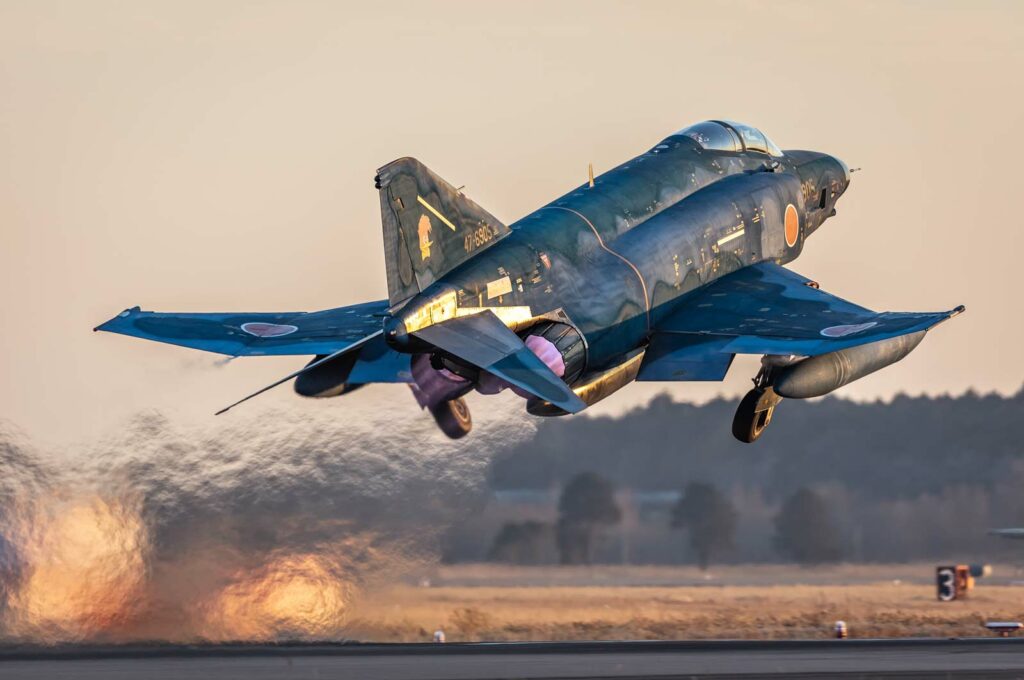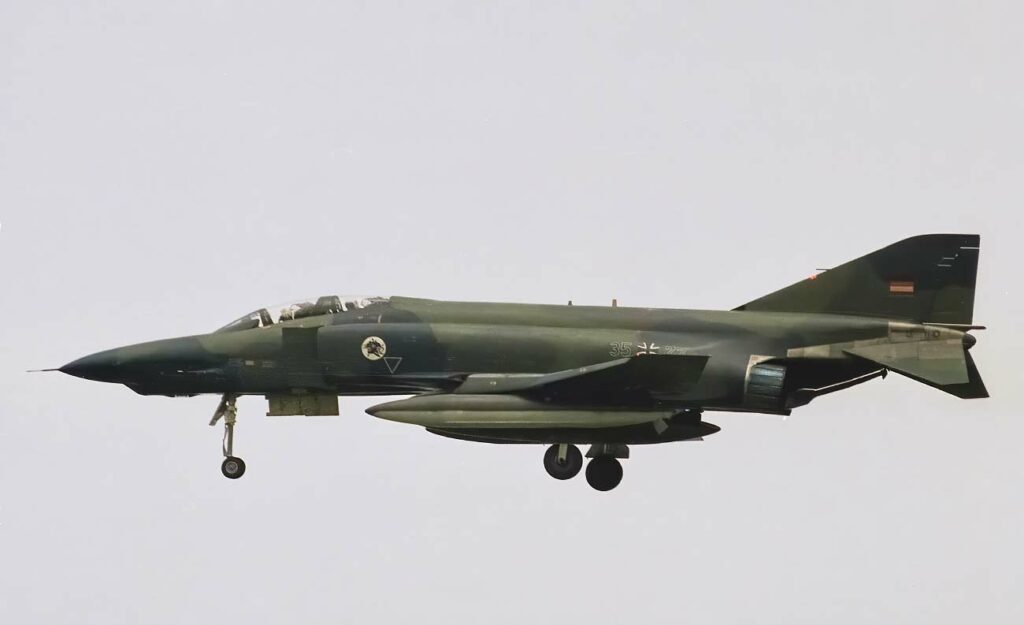The RF-4 Phantom II is a tactical reconnaissance variant of the legendary F-4 Phantom, optimized for high-speed, long-range photo and electronic surveillance.
In brief
The McDonnell Douglas RF-4 Phantom II, a tactical reconnaissance aircraft, evolved from the iconic F-4 Phantom fighter jet. Designed for high-speed, long-range photo and electronic intelligence gathering, it lacked the standard armament of its fighter counterparts to accommodate advanced reconnaissance systems. Equipped with sophisticated cameras and sensors, the RF-4 could operate in all weather conditions, day or night. Its two-engine configuration provided powerful thrust, ensuring rapid transit to and from target areas, maximizing its effectiveness in intelligence, surveillance, and reconnaissance (ISR) roles. Serving numerous air forces worldwide, the RF-4 combined the robust, versatile airframe of the Phantom with state-of-the-art reconnaissance technology.
The McDonnell Douglas RF-4 Phantom II stands as a significant adaptation of one of the most versatile and potent aircraft ever built, the F-4 Phantom. This reconnaissance variant was engineered to meet the growing need for tactical aerial surveillance, capitalizing on the Phantom’s exceptional performance characteristics without compromising on speed or operational altitude.

History of the Development of the McDonnell Douglas RF-4 Phantom II
During the Cold War era, the strategic importance of aerial reconnaissance became increasingly apparent, prompting the development of dedicated aircraft capable of undertaking these missions with minimal risk and maximum efficiency. The McDonnell Douglas RF-4 Phantom II was developed to meet this need, providing the U.S. and its allies with unparalleled capabilities in aerial photography, electronic surveillance, and later, tactical reconnaissance.
Originating from the highly successful F-4 Phantom fighter jet, the RF-4 variant was specifically modified for reconnaissance missions. Launched by McDonnell Douglas in the late 1950s, the program aimed to create an aircraft that could deliver detailed intelligence from behind enemy lines without being detected or intercepted. The first RF-4C flew on May 27, 1964, marking the beginning of a new era in military reconnaissance.
The aircraft was designed to operate at high speeds and altitudes, evading enemy radar and surface-to-air missiles. Its development was a testament to the evolving military strategy of the United States, emphasizing the importance of intelligence gathering in modern warfare. The RF-4 Phantom II was not assigned a specific NATO nickname, consistent with the tradition of its F-4 Phantom lineage.
The necessity for such an aircraft was driven by the intense requirements of the Cold War, where information on enemy activities was as crucial as outright firepower. The RF-4 was a response to this demand, providing a platform that could gather essential data without engaging in direct combat, thereby reducing the risk to American forces and enhancing the overall strategic awareness of the military.
Design of the McDonnell Douglas RF-4 Phantom II
The RF-4 Phantom II maintained the robust design of the original F-4 Phantom but with significant adaptations for its reconnaissance role. It featured a nose specially modified to house cameras and sensors instead of the fighter version’s radar and armament. The aircraft’s design facilitated high-speed, low-altitude flights necessary for tactical reconnaissance, with a maximum speed of over Mach 2 and an operational ceiling above 50,000 feet (15,240 meters).
The RF-4’s airframe was adapted to accommodate up to five cameras in its redesigned nose section, offering panoramic, oblique, and vertical photographic capabilities. The aircraft could carry a variety of sensor payloads, enabling it to conduct photo-reconnaissance, electronic intelligence (ELINT), and infrared imaging. Despite these modifications, it retained the Phantom’s two-seat configuration, high-performance jet engines, and significant fuel capacity, ensuring it could undertake extensive missions over hostile territory with relative impunity.
However, the focus on reconnaissance meant that the RF-4 was typically unarmed, relying on its speed, maneuverability, and electronic countermeasures for defense. This lack of armament was a calculated risk, prioritizing stealth and information gathering over combat capabilities. The design’s main drawback was its vulnerability to modern anti-aircraft systems, necessitating complex operational planning to minimize exposure to threats.
The RF-4’s contributions to aerial reconnaissance included introducing advanced photographic equipment and sensors, which provided invaluable intelligence across various military operations. Its ability to deliver detailed, real-time data from deep within enemy territory was unmatched at the time, making it an essential asset for military strategists and commanders.
Performance of the McDonnell Douglas RF-4 Phantom II
Powered by two General Electric J79-GE-15 engines, each producing up to 17,000 pounds of thrust with afterburner, the RF-4 Phantom II exhibited exceptional performance characteristics. It could reach speeds of over Mach 2.2 (1,460 mph or 2,350 km/h) and operate at altitudes exceeding 50,000 feet (15,240 meters). The aircraft’s range was extended to about 2,600 miles (4,184 kilometers) with external fuel tanks, enabling long-duration missions.
In comparison to its contemporaries, the RF-4 stood out for its superior speed, altitude capabilities, and reconnaissance versatility. Its performance allowed it to outrun threats and ensured the high-quality capture of intelligence data, a crucial advantage over other reconnaissance aircraft of the era, which were often slower or had lesser payload capacities.
The RF-4’s operational effectiveness was not merely theoretical; it was proven in various reconnaissance missions where speed, agility, and the ability to gather high-resolution imagery were paramount. Its advanced sensor suite, capable of day/night and all-weather operations, set a high standard for tactical reconnaissance aircraft, often outperforming competing platforms in terms of operational flexibility and the breadth of its intelligence-gathering capabilities.
Variants of the McDonnell Douglas RF-4 Phantom II
The RF-4 Phantom II was produced in several variants, each designed to meet the specific requirements of the operating forces. The primary versions were the RF-4C, used predominantly by the U.S. Air Force, and the RF-4E, an export model with enhanced features, including improved engines and avionics. The RF-4C was optimized for daytime operations initially, while later modifications incorporated advanced sensors for all-weather, nighttime capabilities. The RF-4E, on the other hand, was adapted for a broader international market and featured a more versatile reconnaissance suite.
Other specialized variants included the RF-4B, used by the U.S. Marine Corps, with modifications suited to their specific tactical reconnaissance requirements. Each variant of the RF-4 maintained the high-performance standards of the original Phantom II design while incorporating advancements in reconnaissance technology and mission adaptability.

Military Use and Combat of the McDonnell Douglas RF-4 Phantom II
The RF-4 Phantom II was extensively deployed in various conflicts, most notably during the Vietnam War, where it conducted crucial reconnaissance missions over hostile territories. The aircraft’s ability to gather detailed intelligence on enemy movements, fortifications, and resources played a vital role in strategic planning and operational effectiveness. It executed these missions with a high degree of success, often under intense anti-aircraft fire.
The RF-4’s operational history also includes significant roles in the Cold War’s proxy conflicts, the 1973 Yom Kippur War, and Operation Desert Storm, where its reconnaissance capabilities were instrumental in coalition forces’ success. Its speed and high-altitude performance enabled it to conduct missions that were beyond the reach of enemy defenses, capturing critical intelligence that informed military decisions and actions.
Despite facing competition from emerging reconnaissance technologies and platforms, the RF-4 remained a valuable asset in military arsenals until its gradual retirement. Various air forces around the globe operated the RF-4, highlighting its effectiveness and the high regard in which it was held internationally. The aircraft was eventually phased out as newer technologies and platforms with stealth capabilities and advanced electronic systems came into service, like the U-2 spy plane and satellites.
Technical Conclusion
The McDonnell Douglas RF-4 Phantom II exemplified the pinnacle of Cold War reconnaissance technology, blending speed, performance, and photographic capability into a platform that could deliver critical intelligence swiftly and accurately. Its legacy endures in the annals of military aviation history, marking a period when aerial reconnaissance was indispensable to national security and military strategy. The RF-4’s contributions to tactical reconnaissance set a high standard for future aircraft, influencing subsequent designs and strategic doctrines in aerial intelligence gathering.
Back to the Spy Planes section.